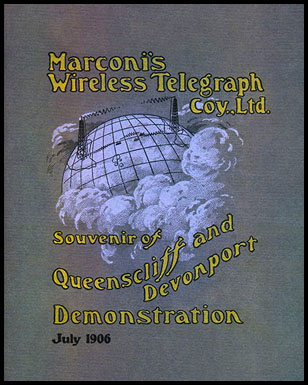Stages in the development.
- Home, index, site details
- Australia 1901-1988
- New South Wales
- Overview of NSW
- Telegraph lines
- Telegraph Offices
- Date stamps
- Forms
- Envelopes
- Rates
- Stamps
- Queensland
- Overview of Qld
- Telegraph lines
- Telegraph offices
- Date stamps
- Forms
- Envelopes
- Rates
- Stamps
- South Australia
- Overview of SA
- Telegraph lines
- Telegraph Offices
- Date stamps
- Forms
- Envelopes
- Rates
- Stamps
- Tasmania
- Overview of Tasmania
- General developments
- Reports
- Organisation
- Telegraph lines
- Telegraph Offices
- Date stamps
- Railway lines
- Forms
- Envelopes
- Rates
- Stamps
- Overview of Tasmania
- Victoria
- Overview of Vic.
- Telegraph lines
- Telegraph offices
- Date stamps
- Forms
- Envelopes
- Rates
- Stamps
- Ephemera
- Western Australia
- Overview of WA
- Telegraph lines
- Telegraph Offices
- Date stamps
- Forms
- Envelopes
- Rates
- Stamps
After Marconi’s experiments successfully demonstrated that long distance communication was possible with shortwave (up to 100 m wavelength) directional transmission and high powered transmitters, his company installed transmitters for sending and receiving messages in Queenscliff, Victoria and Devonport, Tasmania in 1906. The Government did not, however, purchase the equipment nor approve the service. The Government did however place £10,000 on the estimates to cover the cost of erecting two coastal wireless stations - at Sydney and Fremantle. Decision making was slow with the new Government and the amount was rolled over in the Estimates until 1910 when it was increased to £15,000. Finally tenders were called for the construction in 1910.
The main stages in the development of the AWA telegraphic operation were:
| 1905 | The Wireless Telegraphy Act is passed by the Parliament of the Commonwealth of Australia - setting the scene for communications policy for the next 100+ years. | |
| 1906 (July) | First demonstration of wireless technology in Australia (Queenscliff, Vic. to Devonport (Tas.)). |  |
| 1909 (10 September) | The House of Representatives resolved that wireless telegraphic stations should be established around the coasts of Australia and that merchant ships should be equipped with wireless installations. | |
| 1910 | The Government called tenders for the first of these wireless stations - at Sydney and Fremantle - with the contract being awarded on 8 April to a group of local businessmen in association with Telefunken (Germany).
After a dispute with Marconi was settled, the company merged to become Amalgamated Wireless (Australasia) Ltd (AWA) and it also took over other interests including the Australian interests of Marconi and Telefunken. |
|
| 1914 | 19 coastal wireless telegraphy stations were operational. | |
| 1918 (22 September) | The first direct wireless messages from England was received at Wahroonga, Sydney at the home of AWA’s Managing Director Ernest Fisk. Two communications were received – from Prime Minister Billy Hughes (at 1:15pm) and then from the Minister of the Navy Joseph Cook (at 1:25 pm). | |
| by 1922 | The Government had taken a direct interest (50% + one share) in AWA. It then entered into an agreement for AWA to establish high-powered telegraphic and radio stations providing a 24-hour international radio telegraph service. This went against the plans of England who did not appreciate a colonial Prime Minister using his new government-controlled wireless company to interfere with “Mother England's rights” to communicate with its colonies. | |
| 1922 (24 April) | The first link in the Imperial Wireless Chain was opened between Leafield in Oxfordshire and Cairo, Egypt. This chain was seen as being a strategic international wireless telegraphy communications network, created to link the countries of the British Empire. | |
| 1924 (6 March) | Marconi and AWA successfully transmitted messages using secretly built transmission and receiver towers for 90 m transmission in England (at Poldhu) and in Sydney (at the public radio station 2FC in Willoughby – managed by AWA). Later tests showed a 25 m wave was best because it travels better in the dark. | |
| 1927 (8 April) | The Beam Wireless service between Australia and Great Britain and Europe commenced commercial operation using a transmitter at Ballan (near Shepparton), Victoria and a receiving station at Rockbank, Victoria.
The England stations were at Tetney (for transmission – call sign GBH) and at Skegness (Winthorpe - for receiving). |
|
| 1928 (16 June) | The Beam facilities were extended to North America (Canada) and to South America. | |
| 1932 (April) | The Empire Radiotelephone service commenced. | |